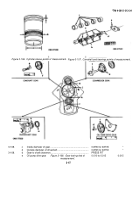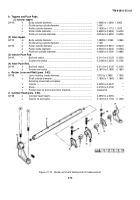TM-9-2815-213-34 - Page 90 of 192
C2,
TM 9-2815-213-34
Check oil pressure and water circulation: look leaks.
(1)
Apply dynamometer load to develop
horsepower at speed (rpm) indicated below.
Maximum Rated HP @ RPM-300@ 3000
Maximum Fuel Rate lbs./hr.-120
Maximum Crankcase Pressue-5
Valve and Injector Settings (130 degrees/150
degrees Fahrenheit)
Injector,
Inch-Pounds-50
Valves: Intake-14,
Exhaust-27
First ½h Hour HP@ RPM-75 @ 2000
Second % Hour HP @ RPM-125 @ 2500
Third % Hour HP @ RPM-150 @ 2700
Fourth ½ Hour HP @ RPM--250 @ 3000
Fifth ½'i Hour HP @ RPM-275 @ 3000
Power check 5 min.
maximum 96 percent Rated
Power-288 @ 3000
(2)
Check
crankcase
blow-by
(paragraph
below).
If not excessive,
reduce run-in time by one-half.
(3)
If blow-by is too high,
run engine for time
period shown under item (1) above.
(4)
At first period only: Run the engine until
temperature reaches 140 degrees Fahrenheit.
Add to
bring level up to "H" mark on dipstick.
(5)
At second period only: Reset valves and
injectors.
Set engine governed speed and fuel rate.
(6)
At third and thereafter: if blow-by is
excessive,
reduce load to preceding phase and run 30
minutes; then return to original sequence and continue
planned program.
c. Blow-By Check.
(1)
Install right bank rocker housing.
Install
sealed type oil dipstick.
(2)
Install right bank rocker housing.
Install
sealed type oil dipstick.
(3)
Attach a manometer to the hose coupling
the checking too (fig 3-98),
and fill the tube w water to
the "0" mark at the middle of scale.
(4)
Manometer
readings
must
be
taken
frequently during the break-in test to note any blow-by
crease.
If there is any increase,
engine speed must
decreased for a few minutes and then brought back
original setting.
(5)
During each 5 minute power check,
keep a
constant check on the manometer.
If the press rises,
more run-in is required.
Maximum press limits for engine
running,
at governed speed a operating at 96 percent to
100 percent of rated horsepower are listed in paragraph
b (1),
above.
(6)
Observe variation in rate of blow-by during
initial engine run.
If the crankcase pressure,
or blow- by
is greater at the end of the testing period than maximum
values listed,
the engine should operated at 96-100
percent rated load and rpm for minutes.
If the blow-by is
not is' not increasing,
although it may be above 5 inches
of water (maximum crankcase pressure),
there is
generally no reason for concern.
As the rings and
cylinder liner combination wear in,
the blow should come
down below 5 inches of water.
If blow-by does not
decrease after 30 minutes,
continue to operate for up to
50 hours.
If blow-by is not below 5 inches of water within
50 hours of operation,
the engine must be considered
unacceptable.
d. Power Check.
(1)
Run engine ar rated speed for 5 minutes.
It
should indicate 96 percent of rated power at standard
fuel rate (120 pounds per hour).
Check crankcase blow-
by.
(2)
If crankcase blow-by exceeds value shown
(5 inches of water),
reduce engine speed and load to
preceding level.
Run engine 30 to 45 minutes.
(3)
Repeat procedures described above until
engine develops 96 percent power (288 horsepower) at
standard fuel rate (120 pounds per hour) within
permissible crankcase blow-by limit (5 inches of water).
CAUTION
Do not exceed 5 minute power check
limitation.
(4)
During power check,
check lubricating oil
as follows:
(a) Oil pressure at idle speed,
10 to 30
p.s.i.
@ 225 degrees Fahrenheit,
at maximum speed,
60 p.s.i.,
maximum.
Lubricating oil pressure should
remain at or near a constant figure at constant engine
speed and load,
after normal operating temperatures
have reached.
NOTE
Abnormally high oil pressures may
indicate restricted lubricating oil lines.
Low pressures indicate an insufficient oil
sup- ply or increased oil clearance which
may be due to bearing wear.
(b)
Under full load conditions,
oil pressure
may drop to 30 p.s.i.
and oil temperature may reach 250
degrees Fahrenheit to 265 degrees Fahrenheit to 265
degrees Fahrenheit for a short period.
This is not cause
for alarm.
CAUTION
Any sudden increase in oil temperature
which is not caused by loading increases
in a warning of possible mechanical
failure and should be investigated at
once.
(c)
After the first 5 to 10 minutes operation the
engine should be shut down and engine oil added to
compensate for engine oil absorbed by filters.
3-61
Back to Top




















